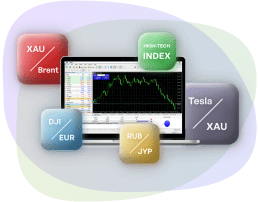- Education
- Introduction to Trading
- Margin Trading
Margin Trading – Trading on Margin
Typical transaction volume in the interbank trading estimates millions and even billions of US dollars. The participants of the interbank market include banks and their clients - the largest multinational corporations, hedge funds and private investors. Thus, it is evident that the transaction volumes on this market are too high for the majority of private investors.
Online trading in Foreign Exchange market has become available to individuals due to emergence of dealing, brokerage companies that act as an intermediary between traders and the market. Currently investors are able to enter the market with a deposit of $100 – $200 due to margin trading, i.e. trading by leverage that increases trading resources for several times. The principle is simple: the broker requires a certain deposit for providing clients with a leverage that enables them to realize transactions with higher volumes possessing a relatively lower capital. In case of suffering losses, clients lose only the invested sum. This type of trading is called trading on margin or margin trading. Margin in this case is the pledge that the broker temporarily holds from the client's deposit for opening positions of certain volumes.
Learn more about What is Leverage in Forex
Each margin trading operation is carried out in two phases: opening a position and closing it. For instance, if the client expects that Euro rate will increase against the Dollar, he buys Euro planning to sell it later with more expensive price. In this case the operation will look like this – buying Euro will be the opening of the position and selling it will be its closing. Such a position will be referred to as a “long position on Euro”. The situation is vice versa if the Euro is expected to fall relative to the Dollar. In this case the investor sells the Euro (opening of the position) in order to buy it at cheaper price later (closing of the position). This position is usually called “short position on Euro”. It may be implied from the above mentioned, that it is possible to make profit in online trading both in case of rising and falling markets.
As mentioned in the beginning, for retail clients Forex market is usually accessible via an intermediate entity, i.e. a Forex broker which acts as a communication channel, provides live quotations and transfers trading orders of the clients to the interbank market. Due to these brokers retail clients are able to access Forex market without having to be physically present at the dealing office. It is enough to be connected to the Internet and install a fully functional trading station on a PC, tablet or any other mobile device which brings Forex trading to a wider audience than ever before.
It is worth to mention that on the world market there are extremely rare situations when currency rates relative to each other vary by more than 3 – 4 percent during a day, and losing the deposit in case rational trading is almost impossible. If the price fluctuation is too strong that the losses may exceed the client's deposit, the broker can close the position with a loss on its own.
To summarize, trading on margin is attractive due to its accessibility, since entering the market requires only 1-3% of the position volume. The answer to the question what is margin trading is quite simple: it is an opportunity given to investors to open large positions possessing a small amount of money and to increase their potential profits. Surely, they should not forget about the possible losses as well, that may result in irrational trading that can be avoided in case of developing trading strategies and following them.





